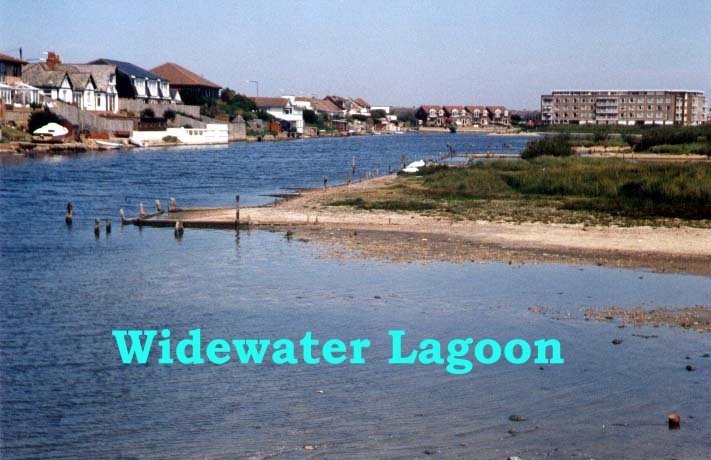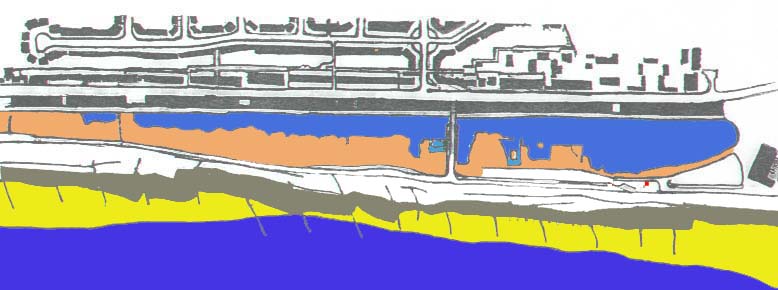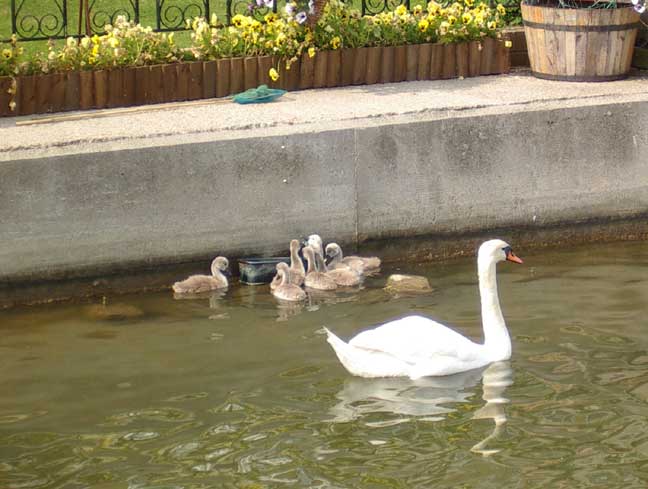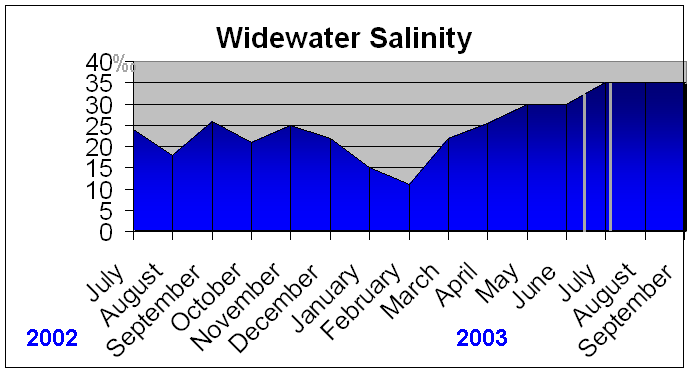 |
|
|
 |
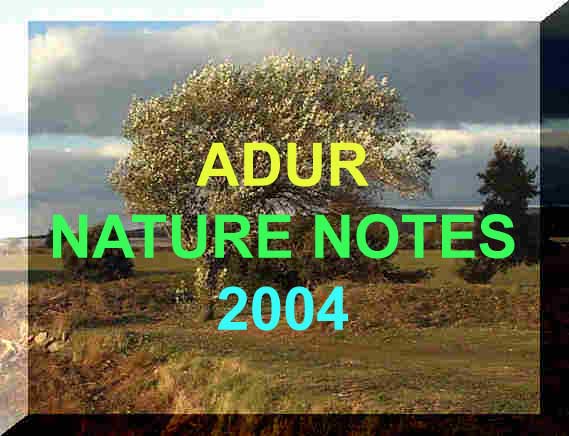 |
|
|
 |
|
FLOOD PLAIN |
| Coastal Fringe |
| Chalk Downs |
| Intertidal (Seashore) |
| River Adur Estuary |
| River Adur Flood Plain |
| Sea (off Sussex) |
| Town & Gardens |
| Widewater Lagoon |
 |
| Saline Lagoon Links |
| Brooklands Boating Lake |
|
|
Widewater
Widewater is a landlocked brackish lagoon approximately 1200 metres long and 50 metres at its widest point when the lagoon is in flood. It was created by Man from the original Adur estuary after been landlocked by longshore drift and violent storms. The waters are replenished by the sea, which filters up through the basin of the lagoon on very high tides, and also by rain water. There is a dramatic rise in the level after heavy rainfall, more than can be explained by the rain landing directly on the lagoon flood plain. Man has built up banks on the perimeter of the lagoon to prevent flooding to this nearby reclaimed land, now turned to residential use. The quantity of water contained within the lagoon and salinity are liable to fluctuate wildly. The flood plain covers an area of 18.5 acres.
by Steve Barker
Since May 2013 a pipeline has been installed to supplement the water levels in Widewater during the summer when the water levels would previously fall to a very low level.
This area can be reached from Shoreham-by-Sea railway station following the purple route on the Map. Click on the underlined text.
- Underwater
Critters
3-spined Sticklebacks,
Gasterosteus
aculeatus. This fish seems to have disappeared
from Widewater Lagoon in 2002 and the reason for this is not known. The
fish has been replaced by thousands of small prawns. A stickleback was
seen again on 9
September 2004.
Hoglice Idotea chelipes (=I. viridis).
Photograph
by Andy Horton
One species of this large
woodlice-type crustacean has been identified from the lagoon. It is an
inhabitant of non-tidal lagoons and can tolerate full salinity to almost
fresh water down to 0.4%. It will also inhabit the pools that are cut off
from the main body of the lagoon during the summer.
----------------------------------------------------------------------------
Bilge
Bug (or Sea Slater) Ligia oceanica
 Photograph by Steve Barker
Photograph by Steve Barker
The largest of the British wood lice feeds on decaying vegetation at the margins of the lagoon.
SEA
SLATERS
http://www.acs.ucalgary.ca/~sakurai/whyligia.html
Lagoon Cockle Cerastoderma glaucum
Lagoon Cockle and Glasswort
A recent survey (1997) has rediscovered this cockle which resembles the Common Cockle, Cerastoderma edule, but has a much thinner shell and is only to be found in brackish water.
Lagoon Cockles have byssus threads and I found juveniles often attached to seaweeds and other substrates. I never noticed byssus threads in Common Cockles. Grown Lagoon Cockles may bury themselves as well, but never so deep as Common Cockles.
Some
notes on the Lagoon Cockle
Sea
Anemone Edwardsia ivelli
A recent survey (1997) failed
to discover this sea anemone and it has now been pronounced extinct. It
was last recorded in 1983.
The
1997 survey by Robert Irving
took 8.5 cm diameter cores from various positions (about 10 in all) throughout
the lagoon, marked on the site map in the Report. Cores were to a depth
of approx. 8 cm, but also surface scrapes into polythene bags under water,
probably the top 5 cm or so.
A
search will be undertaken next summer. See
notes.
This
sea anemone is protected under Schedule 5 of the Countryside
and Wildlife Act 1981, but a proposal has been penned to remove it.
JNCC
Proposal to remove Edwardsia ivelli from Schedule 5 protection (Link)
The grid ref for the collected
specimens was TQ 202 043.
As
the anemone may still be extant, the proposal to remove the sea anemone
from the list has now been removed.
Countryside
and Rights of Way Act 2000
UK Biodiversity Edwardsia ivelli
There is a possibility that the above sea anemone was a deformed specimen of Haliplanella lineata (my surmise AH). This latter typical brackish water sea anemone has been discovered and identified in July 2002.
Hydrozoan
Thieliana
navis (=Clavopsella
navis)
A
rarely recorded brackish water hydrozoan is found in brackish water down
to a salinity of 0.8% and its only habitat of note in the United Kingdom
is the Widewater Lagoon, where it is found attached to the seaweed Chaetomorpha
linum and Ulva. This hydrozoan does not have a medusa stage.
It grow to a length of 30 mm. This species has been discovered in the Kiel
Canal and probably occurs in the Baltic Sea, a traditional and current
trading area with Shoreham Harbour. It is possibly
an
alien species
introduced a long time ago, although Widewater has been cut off from a
direct link to the sea for over a century. The numbers of this hydroid
may be reduced by the 3-spined Sticklebacks.
The
1997 survey failed to discover this hydroid.
The
species was added to Schedule 5 of the Wildlife and Countryside Act 1981
in 1998, after being penned for inclusion in August 1996 (included in Torpedo
Issue 5).
More
Information and Protection Status
The
origin of this hydrozoan is apparently unknown and the only recent records
come from Widewater Lagoon and several localities in the SW Netherlands.
In the past is has been recorded from ship's hulls in Cape Town (South
Africa) and from one locality in the Baltic near Kiel (Germany).
Its
present name is Thieliana navis. It seems to prefer a salinity of
about 20 ppt. It grows on boulders, invertebrates, algae and plants. In
the Netherlands and GB it occurs in enclosed man-made water bodies of relatively
recent (last century) origin.
Black-spot parasite Cryptocotyle
lingua
There do not appear
to be any large winkle-sized gastropods
living in Widewater. This is interesting as it appears as one of the
stages in the life cycle of the flatworm Cryptocotyle
lingua. The host Sticklebacks seem to have disappeared and were
not seen in 2003.
Chaetomorpha
linum
Cladophora
dalmatica
Enteromorpha
flexuosa
Ulva
lactuca
Ulva
rigida
Rhizoclonium
tortuosum
(Information supplied by Robert Irving)
By
2004, the algae I Widewater Lagoon has changed and these species will not
occur in abundance.
Green Tufted Seaweed
The algae in the lagoon includes the annual Cladophora. The Sticklebacks used to make their nest amongst it in the spring. By late summer, it breaks free and forms a mat on the surface of the remaining water. During 2003, it was noticed that most of the Cladophora had disappeared and there were no sign of the thousands of Sticklebacks.
Flowering Plants
Glasswort, Salicornia, grows on the margins of the lagoon where patches turn red in autumn. There are several species but this plant is so variable in appearance that it will need experts to distinguish them to species level.
Glasswort
showing the varying appearances of the plant (September 2001)
The
plant on the far right is the young shoots of Sea Blite, Suaeda
maritima.
Click
on the image for a large view.
Glasswort:
Query, still under investigation (Link)
Frequently, but by no means always, the species that turn red are referred to as Salicornia ramosissima. (Tony Davy)
Sea
Heath, Frankenia
laevis, was recognised in 2000, in a area that had previously been
fenced off to the public to protect the breeding area of the Ringed Plover.
A large patch of this plant was discovered. This plant is very rare in
Sussex known only from Rye Harbour, but it has possibly been missed on
the fringes of salt-marshes.
This
plant has now been found be a genuine wild specimen and NOT a garden escape.
It was already listed in Betty Bishop's, Flora of Shoreham-by-Sea (1984).
Image
(Link to) Widewater Page (by Ray Hamblett) including a photograph of the Sea Heath
The rooted plant with the scientific name of Ruppia maritima seems to have disappeared from Widewater Lagoon in the second half of 2003. This straggly plant is only an occasional inhabitant of the lagoon in any noticeable amounts.
Contact:
- Meetings
| News
20
July 2004
28
May 2004
May
2004
The beach has been fenced off to prevent public access. Wildlife Reports Link to Widewater Reports 2005 29
December 2004
15
December 2004
1 December
2004
Little
Egret, Black-headed Gull and Turnstone on Widewater
On reflection, I think this is more likely to have been a Turnstone than anything else, the deeper water hiding its orange legs, and its beak looking longer than it was. Turnstones and Sanderlings have been reported feeding on Widewater, undoubtably encouraged because of the low water levels because of the lack of rain. The Sanderlings will pitter-patter over the beach sand on a low spring tide, but on the neaps and at high tide, I am not sure where they go? 23
November 2004
17
November 2004
3 November
2004
20
October 2004
14
October 2004
These may have been a quarrel with intruders. This years' cygnets are still greyish in colour. 12
October 2004
9
September 2004
The
Sticklebacks
have not been seen regularly for about two years. The
depth of water in the lagoon measured 1 metre 42 cm on the gauge.
September
2004
Report
by David Wood
The depth gauge by the bridge read 1 metre 55 cm. 1 September
2004
21
August 2004
Early
August 2004
Report
by David Wood
5 July
2004
16
June 2004
The Mute Swan family with their seven cygnets swam amongst where the straggly weed Ruppia was seen again in the shallow parts of the lagoon near the submerged Tamarisk north of the bridge near the multiple islands. The Ruppia seeds may have been introduced by birds. 4 June
2004
2 June
2004
28
May 2004
There were at least two Little Egrets feeding on the lagoon margins, but in the shallow water, there was not the thousands of prawns normally seen, just a score or so were visible. Near the pipeline inlet a dozen Common Gobies, Pomatoschistus microps, could be seen darting to and fro over the silt. May
2004
15
May 2004
Colonisation was expected to be swift and one year later the shingle is covered by the blue-violet of Ivy leaved Toadflax, with splatterings of other ground-hugging plants like Scarlet Pimpernel, small patches of Stonewort, clumps of Sea Campion, one or two Bird's Foot Trefoil, and a few small Sea Kale plants. Sea Thrift produced the usual attractive sweeps over the gravel, but none of this had actually sprouted forth from the disturbed ground. A Ringed Plover was well camouflaged against the shingle and plants. Common Goby There were thousands of small prawns, probably Palaemon elegans but there were still no 3-spined Sticklebacks, Gasterosteus aculeatus, to be seen. There was one new very small fish species though: the Common Goby, Pomatoschistus microps, which was to be expected* with the new pipeline and might have even have occurred before. (* It is found in Hove Lagoon.) A handful were seen, but there are probably hundreds. 12
May 2004
6 May
2004
The Sea Campion (illustrated above) was in flower on the lagoon flood plain. 13
April 2004
24
March 2004
Immigrant Wheatears have been seen on the beach in the last few days. Various
Wheatear reports, including the beach next to Widewater
11
February 2004
Report
by Bob Kent (Lancing) on the
the Sussex
Birds Yahoo Group
EMail
Address for sending in wildlife reports from the lower Adur valley
 28
December 2003 28
December 2003
After over 40 mm of rain the previous day and over night, the water level of Widewater Lagoon on the gauge by the bridge is 1 metre 66 cm, the highest level recorded in 2003.
The area between the lagoon and the beach is particularly good for small birds including: Ringed
Plover
The Habitat Action Plan for Sussex on Saline Lagoons has been published by WSCC. UK Biodiversity: Action Plan for Saline Lagoons Adur Biodiversity: Notes on Action Plan |
Script and page design by © Andy Horton 1997-2004
Widewater has not been designated a Site of Special Scientific Interest (SSSI). It is a Local Nature Reserve.Conjectural outlet of the River Adur in medieval times (link)
THE ADUR ESTUARY
A SURVEY OF THE MARINE FLORA AND FAUNA
1960 TO 1992RAY HAMBLETT'S WIDEWATER LAGOON PAGE
Orford Ness: Coastal Ecology of a Shingle Bank (excellent references)
Local Wildlife Links (SE England)
Adur Biodiversity Exhibition 2001
Adur & the Downs: Protected Sites
Adur Valley Nature Notes 2003
Adur Valley Nature Notes 2002
Adur Valley Wildlife
Adur Wildlife Gallery
Birds of Sea & Seashore (BMLSS)
Brooklands Boating Lake
Carmarthen Bay Saltmarsh SAC
Dungeness, Kent, England
Friends of Widewater Lagoon
Orford Ness: Coastal Ecology of a Shingle Bank (excellent references)
Ralph Hollins Nature Pages (Chichester Harbour area)
Rockpooling Page
RSPB Saline Lagoons
Rye Harbour Nature Reserve
Seashore Page
Shingle Coast (Coastal Fringe of Shoreham Beach)
Shoreham-by-Sea Wildlife Page
Sussex Wildlife Web Sites
Verdant Mud (Glasswort)
Widewater Lagoon Slide Show (by Ray Hamblett)
|
|
|
|
|
|





